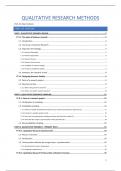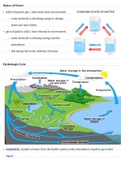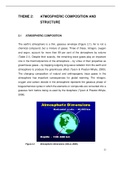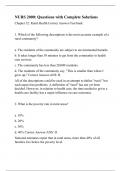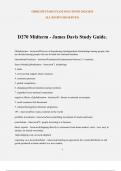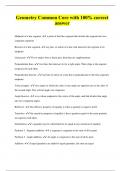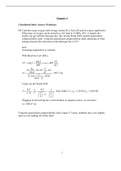CHOICE ARCHITECTURE CLASS NOTES2023
LECTURE 1: Introduction to Choice Architecture............................................................................................... 2
Normative models.......................................................................................................................................3
Descriptive models................................................................................................................................................. 4
Prospect theory:......................................................................................................................................... 4
Reference dependence:............................................................................................................................. 4
The endowment effect:............................................................................................................................... 5
What is utility/value?...................................................................................................................................6
What creates the reference points?...................................................................................................................6
Learning......................................................................................................................................................6
Mental accounting:..................................................................................................................................... 6
Bounded rationality:....................................................................................................................................6
Heuristics and biases.........................................................................................................................................7
Heuristics:...................................................................................................................................................7
Biases:........................................................................................................................................................7
The availability heuristic...................................................................................................................... 8
The affect heuristic.............................................................................................................................. 8
The representativeness heuristics.......................................................................................................9
Elimination by aspect.......................................................................................................................... 9
The anchoring effect..........................................................................................................................10
Non-heuristics: Decision making under limited information............................................................................. 10
Information leakage (Sher and Mckenzie 2006).......................................................................................10
Framing effects..................................................................................................................................10
LECTURE 2: Preference construction, information processing, dual-process theories............................... 11
Ecological validity.............................................................................................................................................11
Preference construction................................................................................................................................... 11
Differential information processing........................................................................................................... 12
Dual-process theories...............................................................................................................................12
Bounded rationality............................................................................................................................12
Not all heuristics are alike................................................................................................................. 12
The adaptive decision maker............................................................................................................ 13
Contextual features.................................................................................................................................. 14
Latent preference/value.....................................................................................................................14
Systematic error (bias)...................................................................................................................... 14
Random error (noise)........................................................................................................................ 14
Attribute framing................................................................................................................................ 14
Default effects................................................................................................................................... 15
LECTURE 3: Biasing, debiasing and rebiasing: a framework.......................................................................... 15
What determines the importance of something:.............................................................................................. 15
Latent value..................................................................................................................................................... 16
Systematic errors (bias)...................................................................................................................................16
Random error (noise).......................................................................................................................................17
Association-based errors................................................................................................................................. 18
(Arkes, 1991)............................................................................................................................................ 18
What is wrong with our associations?...................................................................................................... 19
Ecological validity:............................................................................................................................. 19
How do we fix these errors?..............................................................................................................20
Psychophysical-based errors...........................................................................................................................20
(Arkes, 1991)............................................................................................................................................ 20
How do we fix these errors?..............................................................................................................21
1
, Strategy-based errors...................................................................................................................................... 22
How to fix these errors?.................................................................................................................... 23
Training............................................................................................................................................................ 24
LECTURE 4: Libertarian paternalism and choice architecture.........................................................................24
What are strategy-based errors?..............................................................................................................24
Habit formation & habit retention:......................................................................................................24
Spreading activation:.........................................................................................................................24
Review L3.................................................................................................................................................26
What is the association-based error?................................................................................................26
How do you correct it?.......................................................................................................................26
What are psychophysical-based errors?........................................................................................... 26
How do you correct them?................................................................................................................ 26
Case 1: organ donation defaults...............................................................................................................27
Inference making:..............................................................................................................................27
Status quo bias:.................................................................................................................................28
Case 3: sorting of options.........................................................................................................................28
Case 4: evaluative labels..........................................................................................................................29
Case 5: evaluative labels v20...................................................................................................................29
Case 6: Manipulating scale of numeric information..................................................................................30
LECTURE 8: countervailing mechanisms, relative effect size and net effects............................................... 30
Countervailing forces....................................................................................................................................... 31
Licencing effect................................................................................................................................................31
Influenza vaccination defaults..........................................................................................................................33
Lecture 9: Countervailing mechanisms, relative effect sizes and net effects.................................................. 34
Choice overload........................................................................................................................................34
ZARA case............................................................................................................................................... 36
LECTURE 1: Introduction to Choice Architecture
What is a nudge?
- Person (we need to know the different people)
- Process (which depends on the environment that they’re put in)
- Choice (output of the process processing actions)
The way that you present the environment of the choice (e.g. taxes) might not condition the
choice, but it will condition the way that somebody goes about with the choice → their
behavior
2
,Any intervention has 2 kinds of actions consequences:
- Alter the choice construction process
- Change attitudes/preferences
How is it that you make choices that are not consistent with your core attitudes/preferences?
E.g. The fly in the urinal
→ men don’t care about spilling, or the fly is not smth that is part of core preferences. But at
that moment, the fly creates a momentary goal in the mind and a visual fixation and the
attention goes to look at the fly rather than smth else. The goal of the intervention is not to
increase the preference, but to reduce the error
Sometimes, the choice construction process may alter your attitudes/preferences.
Normative models
Normative models: what people SHOULD do
→ Provides a mathematical framework for understanding the functional relationship between
everything on consumer’s value/utility
→ Developed for risk/uncertainty
Egalitarianism vs utilitarism:
Normative model: Expected value
optimization
→ More is better
Indifference curves: the trade-offs people
are willing to make
Fungibility: the extent to which something is
exchangeable (cash vs. time)
By understanding the market environment, we can understand why people e.g. pay a lot of
money for a small space
Normative models assume that people have more happiness and more value from more of
good
→ but utility flattens out.
3
, Descriptive models
Specify what consumers ACTUALLY do
→ provides a mathematical framework for understanding the functional relationship between
everything on consumers' value/utility
Prospect theory:
→ individuals assess their loss and gain perspectives in an asymmetric manner. Agents
asymmetrically feel losses greater than that of an equivalent gain. It centralizes around the
idea that people conclude their utility from "gains" and "losses" relative to a certain reference
point. This "reference point" is different for each person and relative to their individual
situation.
Reference dependence:
→ there is an infinite set of reference points but we don’t always think of all of them, if we
can understand what reference points people are utilizing at the moment, we can understand
the judgments they will make. What guides attention to different reference points?
what do I compare any stimulus to?
But where do the reference points come from?
→ Your brain does not know how to create a judgment without pulling out information from
memory, whatever it is.
Negatives in a dimension tend to feel larger than positive
dimensions.
Loss aversion is a steeper slope than the curvature in the
gains
When we think of the utility that people derive from
consumption, the same consumption experience can be
counted as a separate experience or a combined experience.
E.g. you consume one piece of pizza which gives you V(x) utility, then you consume a
second slice of pizza, which gives you V(2x) value, which is a bit less than the utility you got
from the first slice. But if you only consume one slice, then you go to sleep, and the morning
4
LECTURE 1: Introduction to Choice Architecture............................................................................................... 2
Normative models.......................................................................................................................................3
Descriptive models................................................................................................................................................. 4
Prospect theory:......................................................................................................................................... 4
Reference dependence:............................................................................................................................. 4
The endowment effect:............................................................................................................................... 5
What is utility/value?...................................................................................................................................6
What creates the reference points?...................................................................................................................6
Learning......................................................................................................................................................6
Mental accounting:..................................................................................................................................... 6
Bounded rationality:....................................................................................................................................6
Heuristics and biases.........................................................................................................................................7
Heuristics:...................................................................................................................................................7
Biases:........................................................................................................................................................7
The availability heuristic...................................................................................................................... 8
The affect heuristic.............................................................................................................................. 8
The representativeness heuristics.......................................................................................................9
Elimination by aspect.......................................................................................................................... 9
The anchoring effect..........................................................................................................................10
Non-heuristics: Decision making under limited information............................................................................. 10
Information leakage (Sher and Mckenzie 2006).......................................................................................10
Framing effects..................................................................................................................................10
LECTURE 2: Preference construction, information processing, dual-process theories............................... 11
Ecological validity.............................................................................................................................................11
Preference construction................................................................................................................................... 11
Differential information processing........................................................................................................... 12
Dual-process theories...............................................................................................................................12
Bounded rationality............................................................................................................................12
Not all heuristics are alike................................................................................................................. 12
The adaptive decision maker............................................................................................................ 13
Contextual features.................................................................................................................................. 14
Latent preference/value.....................................................................................................................14
Systematic error (bias)...................................................................................................................... 14
Random error (noise)........................................................................................................................ 14
Attribute framing................................................................................................................................ 14
Default effects................................................................................................................................... 15
LECTURE 3: Biasing, debiasing and rebiasing: a framework.......................................................................... 15
What determines the importance of something:.............................................................................................. 15
Latent value..................................................................................................................................................... 16
Systematic errors (bias)...................................................................................................................................16
Random error (noise).......................................................................................................................................17
Association-based errors................................................................................................................................. 18
(Arkes, 1991)............................................................................................................................................ 18
What is wrong with our associations?...................................................................................................... 19
Ecological validity:............................................................................................................................. 19
How do we fix these errors?..............................................................................................................20
Psychophysical-based errors...........................................................................................................................20
(Arkes, 1991)............................................................................................................................................ 20
How do we fix these errors?..............................................................................................................21
1
, Strategy-based errors...................................................................................................................................... 22
How to fix these errors?.................................................................................................................... 23
Training............................................................................................................................................................ 24
LECTURE 4: Libertarian paternalism and choice architecture.........................................................................24
What are strategy-based errors?..............................................................................................................24
Habit formation & habit retention:......................................................................................................24
Spreading activation:.........................................................................................................................24
Review L3.................................................................................................................................................26
What is the association-based error?................................................................................................26
How do you correct it?.......................................................................................................................26
What are psychophysical-based errors?........................................................................................... 26
How do you correct them?................................................................................................................ 26
Case 1: organ donation defaults...............................................................................................................27
Inference making:..............................................................................................................................27
Status quo bias:.................................................................................................................................28
Case 3: sorting of options.........................................................................................................................28
Case 4: evaluative labels..........................................................................................................................29
Case 5: evaluative labels v20...................................................................................................................29
Case 6: Manipulating scale of numeric information..................................................................................30
LECTURE 8: countervailing mechanisms, relative effect size and net effects............................................... 30
Countervailing forces....................................................................................................................................... 31
Licencing effect................................................................................................................................................31
Influenza vaccination defaults..........................................................................................................................33
Lecture 9: Countervailing mechanisms, relative effect sizes and net effects.................................................. 34
Choice overload........................................................................................................................................34
ZARA case............................................................................................................................................... 36
LECTURE 1: Introduction to Choice Architecture
What is a nudge?
- Person (we need to know the different people)
- Process (which depends on the environment that they’re put in)
- Choice (output of the process processing actions)
The way that you present the environment of the choice (e.g. taxes) might not condition the
choice, but it will condition the way that somebody goes about with the choice → their
behavior
2
,Any intervention has 2 kinds of actions consequences:
- Alter the choice construction process
- Change attitudes/preferences
How is it that you make choices that are not consistent with your core attitudes/preferences?
E.g. The fly in the urinal
→ men don’t care about spilling, or the fly is not smth that is part of core preferences. But at
that moment, the fly creates a momentary goal in the mind and a visual fixation and the
attention goes to look at the fly rather than smth else. The goal of the intervention is not to
increase the preference, but to reduce the error
Sometimes, the choice construction process may alter your attitudes/preferences.
Normative models
Normative models: what people SHOULD do
→ Provides a mathematical framework for understanding the functional relationship between
everything on consumer’s value/utility
→ Developed for risk/uncertainty
Egalitarianism vs utilitarism:
Normative model: Expected value
optimization
→ More is better
Indifference curves: the trade-offs people
are willing to make
Fungibility: the extent to which something is
exchangeable (cash vs. time)
By understanding the market environment, we can understand why people e.g. pay a lot of
money for a small space
Normative models assume that people have more happiness and more value from more of
good
→ but utility flattens out.
3
, Descriptive models
Specify what consumers ACTUALLY do
→ provides a mathematical framework for understanding the functional relationship between
everything on consumers' value/utility
Prospect theory:
→ individuals assess their loss and gain perspectives in an asymmetric manner. Agents
asymmetrically feel losses greater than that of an equivalent gain. It centralizes around the
idea that people conclude their utility from "gains" and "losses" relative to a certain reference
point. This "reference point" is different for each person and relative to their individual
situation.
Reference dependence:
→ there is an infinite set of reference points but we don’t always think of all of them, if we
can understand what reference points people are utilizing at the moment, we can understand
the judgments they will make. What guides attention to different reference points?
what do I compare any stimulus to?
But where do the reference points come from?
→ Your brain does not know how to create a judgment without pulling out information from
memory, whatever it is.
Negatives in a dimension tend to feel larger than positive
dimensions.
Loss aversion is a steeper slope than the curvature in the
gains
When we think of the utility that people derive from
consumption, the same consumption experience can be
counted as a separate experience or a combined experience.
E.g. you consume one piece of pizza which gives you V(x) utility, then you consume a
second slice of pizza, which gives you V(2x) value, which is a bit less than the utility you got
from the first slice. But if you only consume one slice, then you go to sleep, and the morning
4

